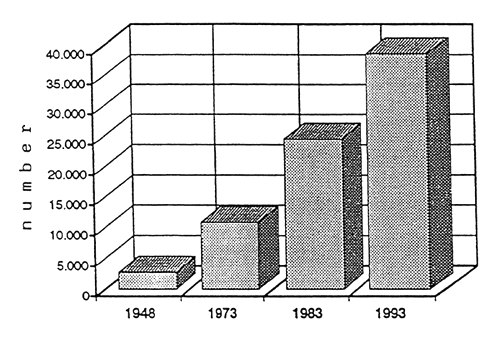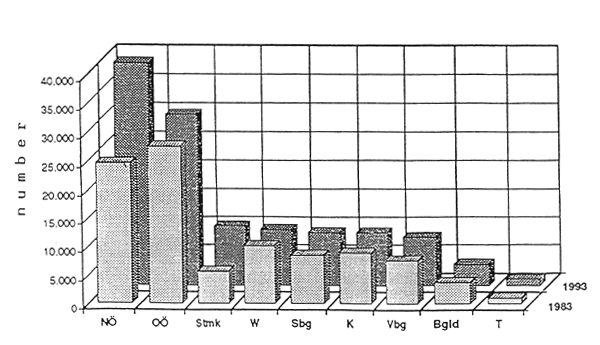E. KAINZ
Bundesanstalt für Fischereiwirtschaft, Scharfling 18, A 5310 Mondsee, Austria
There are about 9 000 lakes in Austria, of which 5 000 are natural and 4 000 man made. Only 26 lakes cover an area of more than 1 km2. About 100 000 km of rivers and brooks are being managed by anglers.
Most fishermen belong to associations, about 440 of which exist in Austria. Some of these belong to a wider organization which covers more than one district. The main organization is the Österereichischer Fischereiverband (ÖFV) whose main task is to promote fisheries of all types and to guarantee and improve the legal position, as well as to promote protection of the waters.
Commercial fisheries were practised to the beginning of this century and, in some cases, up to the 1950s on some of the larger rivers, including the Rivers Danube, Traun, Inn, etc. The strong decrease of fish stocks in these running waters during the first half of this century caused the total decline of the commercial fishery in most of them. The reasons for the decrease are:
At present commercial fisheries are practised only on a few lakes and on a small stretch of the River Danube. Otherwise almost all of the larger running waters and some lakes are being managed by anglers' associations.
Unlike the situation in the commercial fishery, the recreational fishery has been increasing in importance since the Second World War, as shown by the growing number of anglers in Lower Austria (Fig. 1). In the last decade the number of fishery licences sold for fishing on the open waters of Austria has also increased considerably (Fig. 2). The number of fishing licences sold officially amounted to 125 000 in 1983 and 155 000 in 1993. It is, however, almost impossible to ascertain the exact number of licences sold because of the different legal situation in the districts. In Austria fisheries lie within the jurisdiction of the districts.
Fisheries, and especially recreational fisheries, strongly influence fish stocks in running waters with respect to species composition and fish density, both by intensive stocking and by catch. In some waters a put and take fisheries is normal, as are catch and release fisheries. Recently many of the anglers' associations have changed to more ecological management of their waters by catching only the natural yield of fish and promoting their natural propagation.
In spite of these positive actions by anglers the recreational fishery is often strongly criticized by organizations for the protection of nature and animals, especially ornithologists. During the last decade the number of cormorants, herons and otters has increased causing high losses to fish, especially in brooks and smaller rivers. Therefore anglers and fish farmers demand a reduction in the numbers of cormorants and herons. In addition, fish stocks in some rivers have decreased during the last decade due to improvements in water quality connected with a diminution in organic loading of those waters.
Another ground for permanent criticism is the kind of fishery management practised by some anglers' associations, principally:
Future trends in the recreational fishery
Fishing licences of Lower Austria (NÖ)

Fig. 1 Development of the recreational fishery in Lower Austria since the Second World War (after Spindler 1995)
Fishing Licences in Austria

Fig. 2 Number of official fishing licences in Austria between 1983 and 1993 (after Spindler 1995)